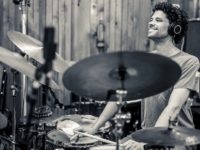Canadian native Anthony Fung has been destined to be a major artist, having been a Berklee product and tutored by so many jazz greats while absorbing both the East and West coast scenes. By the time I came across his handiwork as a sideman on some Dan Rosenboom-led recordings, he was already a forceful drummer with great range.
Fung is more than a good sideman; he’s led a couple of his own dates. He was about to record his third one when the pandemic put those plans on ice. Retreating back to Canada and isolated under quarantine, Fung composed all but two of the songs that make up the album he eventually got to make, What Does It Mean to Be Free.
With greater time for reflection and taking in all the major events unfolding around him, Fung crafted songs that probably have more emotional investment in them than if they were created under normal circumstances. For Free, Fung leads a base quartet comprised of himself, David Binney (alto sax), Luca Mendoza (piano) and Luca Alemanno (acoustic bass) for four of the songs, adding a guest player or two for the other five.
“What Does It Mean to Be Free?” is the most contemporary sounding of all these tracks, due to the rock rhythms and Paul Cornish’s synth touches. But those things don’t matter as much as the strong, forward push of the song, led by Binney’s sax and Andrew Renfroe’s electric guitar wailing — often together — to convey the urgency that Fung doubtlessly intended.
But even in all-acoustic settings, Fung’s song sound fresh and contemporary; he is putting substance behind his stated desire for this record to push jazz beyond its status quo. Moreover, I’ve found drummer composers to generally be better at fully realizing roles for the entire band and not a vehicle for the composer/leader; Fung is no exception.
“El Paso,” an ode to a Texas mass shooting since overshadowed by Uvalde, boasts passionate turns from Binney and Mendoza. The pensive “Dreamer’s Interlude” is all Mendoza, and he rises to the occasion. The understated “Defiance” commences with a lyrical alto sax soliloquy but that’s not Binney; Braxton Cook (as well as Alemanno) is the star this time. “Flashpoint (Revisited)” is a leftover from the prior album of the same name. Rhythm-ing of course, is Fung’s forte, and he integrates complex, shifting rhythms right into this composition, making it far more interesting.
“Sonny’s Blues” is a gently swaying reggae at its foundation, while Marcel Camargo’s guitar injects a twinge of African folk flavoring and Mendoza is once again given ample room to add colorful piano highlights. On another guest turn that helps to bring a Fung song to life, Roni Eytan’s harmonica — so remindful of Toots Thielemans — adds the emotional weight to the gentle “Let Us Not Forget To Be Kind.”
Fung has benefitted from the mentorship of such jazz royalty as Herbie Hancock, Danilo Perez and Wayne Shorter, the latter providing inspiration for Fung’s own take on the Shorter song “Sightseeing.” This nugget from the late 70s Weather Report album 8:30 is brought back to its post-bop core with crafty rearranging that still preserves the spirit of the theme and a perfect tune for Fung to strut his stuff on the drums.
What’s clear from looking at Anthony’s Fung’s background and listening to his music, this man’s head is stuffed full of ideas from all kinds of sources. The triumph of What Does It Mean to Be Free comes from distilling those ideas into an articulate, diverse and unified set of works.
- Nick Millevoi – ‘Moon Pulses’ (2024) - April 23, 2024
- Cannonball Adderley – ‘Poppin’ in Paris: Live at L’Olympia 1972′ (2024) - April 20, 2024
- Christian Marien Quartett – ‘How Long Is Now’ (2024) - April 18, 2024




